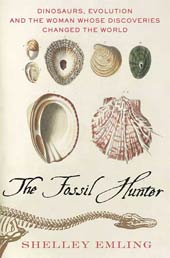 The title: The Fossil Hunter
The title: The Fossil HunterThe author: Shelley Emling
Publication: Palgrave Macmillan, 2009
Got it from: DC, Xmas 2010
You've probably never heard of Mary Anning, but without her our knowledge of fossils and dinosaurs would be considerably poorer. In 1811, she discovered the first complete dinosaur skeleton at only twelve years of age. She spent a lifetime uncovering extraordinary fossils in her hometown of Lyme Regis, but never received proper recognition because she was a woman.
It's hard to comprehend the tremendous strides in science that occurred during the 19th century. In 1800, the world was thought to be a only a few thousand years old, and everything on it, including plants and animals, never changed. The concepts of Ice Ages, evolution and dinosaurs simply did not exist. We tend to think of our own era as one of rapid change, but imagine having your entire view of history swept out from under your feet and replaced with something completely astonishing. It must have been frightening, like suddenly viewing the world upside-down.
For Mary Anning, the poor daughter of a carpenter, it would have been even more incomprehensible. Yet Mary was at the very heart of the discovery of dinosaurs. Learned scientists of the day flocked to meet her and learn about her latest discoveries, men at the forefront of the fossil revolution, including Henry De la Beche, Charles Lyell and Louis Agassiz, the man who first proposed the idea of ice ages. At a time when "gentlemen scientists" stayed comfortably in labs and lecture halls, Mary was scrambling over cliffs in all kinds of weather and practically breaking her back working to extract fossils. It was her discoveries that led to scientists identifying dinosaurs and later influencing Charles Darwin in his theory of evolution. She even inspired the tongue twister "she sells seashells by the seashore."
But for all her effort, she received almost no recognition, was scorned by the people of her town, remained poor all her life and was barred from even attending lectures about her own discoveries. One can't help but feel indignation at Mary's plight. She remained forever at the periphery of the exciting times she lived in, hungering for more scientific knowledge and was by all accounts considered an extremely intelligent woman who impressed her scientific friends. Her life, however, was one of hardship and struggle right up until her death.
Shelley Emling brings Mary to life from the few remaining letters and journals that remain detailing her life. The Fossil Hunter is as much about her as about the history of the early 19th century in which she lived. It's a fascinating story that reads almost like a romance between Mary and fossil hunting, bogged down only in parts by the author's unfortunate tendency to repeat herself. It's a story that deserves to be told about the birth of paleontology and the woman who made it all possible. It's a refreshing change to read about the accomplishments of somebody in science who isn't a man, and I hope everybody interested in the history of fossil hunters reads this and understands what a remarkable contribution Mary Anning made to the field.
No comments:
Post a Comment